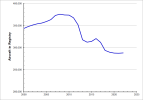Just a random thought, home sick on a cloudy day.....
Thinking about my time in the simple trainers.....trying to compare the 150 vs the 152, pros/cons.....
So ignoring price
and assuming similar condition, and I suppose similarly equipped avionics, etc....
which would you rather have? and why?
I went back to my logbook to see..
Honestly, two differences stand out in my memory. Both are rather superficial/opinion, but both are cons for the 150
1) I hated the momentary press and hold flap actuator control in the 150 (vs the 'push to the next notch and let go' + position indication in the 152)
2) MPH. I prefer Kts in the 152, because everything in planning for aviation seems to be based on the nautical mile....
I don't recall much about performance, except that both were rather slow and both had anemic climb rates
Thinking about my time in the simple trainers.....trying to compare the 150 vs the 152, pros/cons.....
So ignoring price
and assuming similar condition, and I suppose similarly equipped avionics, etc....
which would you rather have? and why?
I went back to my logbook to see..
I have 86.5 hours logged in the C152, spread over seven different aircraft (1978-1982 models, mostly in the '82). Looks like my last flight was in 1999
I have 18.3 hours logged in C150's, spread over four different aircraft, all C150M models. Looks like my last flight was 1997.
I hadn't flown either very much really since about 1995...so my memory is surely faded.
Honestly, two differences stand out in my memory. Both are rather superficial/opinion, but both are cons for the 150
1) I hated the momentary press and hold flap actuator control in the 150 (vs the 'push to the next notch and let go' + position indication in the 152)
2) MPH. I prefer Kts in the 152, because everything in planning for aviation seems to be based on the nautical mile....
I don't recall much about performance, except that both were rather slow and both had anemic climb rates







